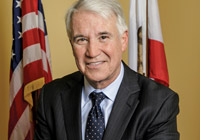Largely because of the effectiveness of its fabled SWAT team, the Los Angeles Police Department rarely kills a hostage or an onlooker, even in confrontations with armed and often disturbed suspects.
But Michel Moore, the department’s new chief, had barely settled into his job this summer when his officers shot, not one, but two bystanders in separate incidents. On June 16, a man held a knife to the throat of a homeless woman in Van Nuys; officers fired, killing both the assailant and the woman. Then, on July 21, a suspect, allegedly fleeing a shooting, led police on a car chase, careened into a utility pole at a Trader Joe’s market in Silver Lake, and fled inside the convenience store; officers exchanged fire with the suspect, killing a store manager.
This tragic pair of events raised concerns about the department, which once was considered a dangerously violent and sometimes racist agency. It is impossible, of course, to judge an organization as large and complex as the LAPD by such a small number of incidents, but I have reported on and written about the department over the years, and I would offer two thoughts.
One concerns intent.
What tarnishes the LAPD’s history have been allegations that some of its officers not only have done harm, but that they did it on purpose – that officers in the Rampart Division in the late 1990s, for instance, who robbed a bank and reportedly stole drugs and threatened suspects, did so to enrich themselves and to brutalize the suspects; there was nothing said to have been accidental about it.
Similarly, among the most shocking aspects of the Rodney G. King beating in 1991 was not only that officers repeatedly struck and kicked King, who had led them on a chase after refusing to be pulled over for speeding, but also that so many other officers watched and did not report any wrongdoing. That suggested a broken police culture, not just some wayward cops.
There is no suggestion that the officers in these shootings intended any harm to the bystanders.
Second is the question of official response.
In the King case, then-Chief Daryl F. Gates at first criticized the officers involved, who had been caught on videotape. But when the LAPD fell under sharp criticism, he defended the department. That sent mixed signals, and Gates, who was combative (he once challenged me to a fist-fight) struggled to toe a straight and consistent line. Mayor Tom Bradley, frustrated and hamstrung by civil service rules that limited his ability to discipline Gates, convened what would come to be known as the Christopher Commission, named for its chairman, attorney Warren Christopher, who would become secretary of state under President Bill Clinton. It was the Christopher Commission that finally showed Los Angeles how to repair its police department.
When details of the Rampart scandal were reported, the city’s leadership waffled between pursuing the wrongdoers and arguing that the outrage was isolated and unique. The U.S. Justice Department bore down, insisting that Rampart was part of a larger LAPD failing and that only federal oversight could fix it. The oversight became a major part of the LAPD’s recovery, but the city’s confused response early on was evidence of deep trouble at the department and with the city leadership.
This time, Chief Moore has sent encouraging signals. He released bodycam and other video and audio recordings that captured the moments leading up to this summer’s two shootings. Some critics suggested the release was self-serving because it showed the stressful situations the officers faced and helped explain their actions. But that’s beside the point. Of course, videos of officers shooting bystanders will demonstrate that the officers were under pressure. No officer wakes up in the morning hoping to shoot a bystander. Such shootings are rare precisely because they are the last thing any police officer wants to be involved in.
In addition, the LAPD made public the names of the officers involved in these incidents, albeit quietly and seemingly with some reluctance. Releasing names is a good practice. For a while, the department had been pulling back from the timely and routine release of officers’ names, an unfortunate departure that did little for officer safety and much to undermine public confidence. Moore’s actions do not suggest an enthusiastic embrace of such releases, but at least the department did what was necessary.
There is a tendency in police accountability for participants to debate in clichés. Police unions defend “officer safety.” Reformers and news reporters demand “transparency.” As this summer’s shootings demonstrate, there is room for both. Officers deserve respect and empathy for the dangerous situations they confront, and the public is entitled to insight into their actions – including their names and evidence that shows why they did what they did. Moore’s first brush with those challenges as chief suggests reason for hope.























